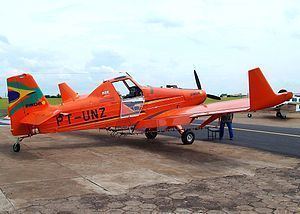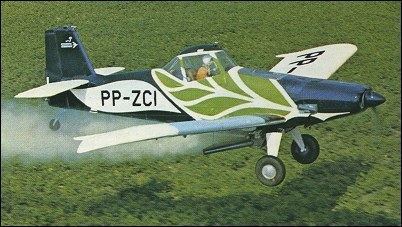Top speed 230 km/h Length 7.43 m First flight 1970 | Wingspan 12 m Introduced December 1971 | |
 | ||
The Embraer EMB 202 Ipanema is a Brazilian agricultural aircraft used for aerial application, particularly crop dusting. It is produced by Indústria Aeronáutica Neiva, a subsidiary of Embraer located in Botucatu, Brazil. The latest version of this aircraft is the first ethanol-powered fixed-wing aircraft, which could give it an economical advantage over the gasoline version. The aircraft is widely employed in Brazil, having market share of about 80%, and the 1,000th delivery was completed on 15 March 2005. Besides aircraft, alcohol-conversion kits for gasoline-powered Ipanemas are also sold.
Contents

Development

In the 1960s, the development of a Brazilian agriculture aircraft was motivated by the expansion of the agricultural products market, specifically soybean and sugar cane. During this time, the Ipanema aircraft was developed by engineers of the Aeronautics Technological Institute (ITA) on the Ipanema Farm, located in Sorocaba.

The first version of the aircraft, the EMB-200, made its first flight in 1970 and was certified in December 1971. The aircraft was equipped with a 260 hp (190 kW) piston engine. Series production started in 1972 by Embraer. In September 1974, the EMB-201 was introduced, including many improvements such as a 300 hp (220 kW) engine, new propeller, new wings and increased capacity.

In 1982, the production of Ipanema was transferred to Indústria Aeronáutica Neiva, recently acquired by Embraer. In 1992, a new model, called EMB-202 or Ipanemão( big Ipanema), was released. The new aircraft had improvements on aerodynamics, a 40% greater capacity, and optional, modern equipment for electrostatic aerial application.
In the following years, Neiva made significant improvements to the aircraft, such as adding winglets to the wingtips, adding an air conditioning system to the cabin, lowering the position of the wings, decreasing resistance and reducing the weight of the exhaust system.
Since ethanol is largely available in Brazil, costing only about 25-30% as much as aviation gasoline, many Brazilian farmers have attempted to fuel gasoline-powered Ipanemas with alcohol, with varying degrees of success. The result of this was the development of an alcohol-powered Ipanema, which was certified by the Brazilian General Command for Aerospace Technology (CTA) on 19 October 2004. The alcohol fuelled Ipanema engine also has 20% lower maintenance and operational costs.
In 2015 an Ipanema with improved winglets was presented on the Agrishow agricultural exposition. The new winglets, designed by the department of Aeronautical Engineering of the University of São Paulo's São Carlos School of Engineering, increased the performance of the aircraft by 20%.
Variants
In parentheses are shown certification dates.
Governmental operators
Specifications (EMB-202)
Data from Jane's All The World's Aircraft 2003–2004
General characteristics
Performance
